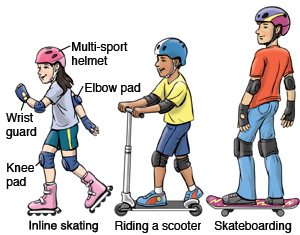Scooter, Skateboard, and Inline Skates Safety
Wheeled sports include riding scooters, skateboarding, and inline skating. These can be fun and great exercise for your child. But these sports can also be dangerous. When done incorrectly, they can lead to injury and sometimes even death. This sheet gives tips for keeping your child safe.
 |
| Wearing proper safety gear can help keep your child safe while doing wheeled sports. |
Safety tips for inline skates, scooters, and skateboards
Safety tips include:
-
Your child must wear safety gear—including a helmet—every time they ride. Make a firm rule that your child cannot ride without it.
-
Equipment should be kept in good shape. For instance, before each ride, your child should check the wheels, brakes, and other equipment. If your child is young, check the equipment yourself.
-
Choose a safe place to ride that is located away from vehicle and pedestrian traffic.
-
Your child should never wear headphones while riding. They need to be able to hear oncoming traffic.
-
Allow your child to ride only during daylight, never at dusk or at night.
Inline skating safety
To keep them safe while inline skating, make sure your child follows these rules:
-
Wear protective gear that fits properly. This includes a helmet, wrist guards, elbow pads, and knee pads. Protective gear should be worn even at a skating rink.
-
Don't hold on to moving vehicles while inline skating.
-
Always skate at a speed at which they can stay in control.
-
Consider taking inline skating lessons when learning to skate. Beginners should skate only at an indoor or outdoor skating rink.
-
Use skates that are the right type and fit for their size and skill level.
Scooter safety
Supervise children riding scooters, especially kids younger than age 8. To keep them safe, make sure your child follows these rules:
-
Wear protective gear that fits correctly. This includes a helmet, elbow pads, and knee pads. Wrist guards should not be used. This is because they can make it hard to grip the scooter’s handlebars.
-
Wear sturdy shoes when riding a scooter.
-
Ride only on smooth pavement. Don't ride on dirt, sand, gravel, or wet pavement .
-
Don't ride a scooter in the street, traffic, or at night.
-
Don't allow passengers on the scooter. Scooters are designed to carry only 1 person.
Skateboard safety
Only children age 5 years and older should be allowed to skateboard. Be sure to supervise skateboarding children, especially kids younger than 10 years old. To keep them safe, make sure your child follows these rules:
-
Wear protective gear that fits properly. This includes a helmet, wrist guards, elbow pads, and knee pads.
-
Wear sturdy shoes when riding a skateboard.
-
Don't skateboard in traffic. Instead, go to a skate park.
-
Don't hold on to moving vehicles while skateboarding.
-
Use a skateboard with wide wheels and a short board (deck) when learning to skateboard.
Helmets for wheeled sports
A helmet can greatly decrease your child’s chance of a head and brain injury from a wheeled sport incident. Multi-sport helmets are best. They give extra protection to the back of the head. This is the part of the head most likely to be injured in wheeled sports. To keep your child safe, do the below:
-
Make sure the helmet is right for the size and age of your child and that it fits well. It should be level on top of the head, about 2 finger-widths above the eyebrows. It should not rock back and forth or side to side. The strap should be buckled and snug under the chin.
-
If you can, take your child to the store to try on the helmet before you buy it. This helps you find one that fits well. It's also helpful because a child who chooses their own helmet may be more likely to wear it. If you can’t bring your child to the store, measure their head before going to the store.
-
Make sure there is a CPSC (Consumer Product Safety Commission) sticker on the helmet. This means the helmet meets the CPSC standard for safety.
-
Don’t use a helmet that has been in a crash. A damaged helmet may not protect the head. Discard it and buy a new one.
-
Set a good example—wear a helmet yourself!
Online Medical Reviewer:
Amy Finke RN BSN
Online Medical Reviewer:
Liora C Adler MD
Online Medical Reviewer:
Stacey Wojcik MBA BSN RN
Date Last Reviewed:
1/1/2022
© 2000-2024 The StayWell Company, LLC. All rights reserved. This information is not intended as a substitute for professional medical care. Always follow your healthcare professional's instructions.